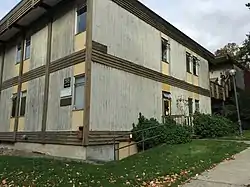The University Transition Program
The Transition Program for Gifted Students, often called the University Transition Program, or simply UTP is an accelerated secondary school program for gifted students funded by the BC Ministry of Education's Provincial Resource Program with hosting, educational support and financial assistance from the University of British Columbia (UBC), and administered by the Vancouver School Board in Vancouver, British Columbia, Canada. Each year, the program accepts around 20 new students between the ages 12 and 15,[1] half of which are from outside the Vancouver School Board.[2] Over the course of two years,[3] students complete required five year high school curriculum along with some university coursework.[4] When they graduate from the program, the students are usually accepted into UBC earlier than they would if they had graduated from a regular high school (aged 14–17 instead of 18–19).
| University Transition Program | |
|---|---|
 University Transition Program, building (visible on the far right of image), Oct 2014 | |
| Address | |
240D - 1924 West Mall , , V6T1Z2 Canada | |
| Information | |
| Established | 1993 |
| School board | School District 39 Vancouver |
| School number | 03995051 |
| Grades | 11–12 |
| Enrollment | 40 (September 2022) |
| Language | English |
| Area | Vancouver, British Columbia |
| Website | universitytransition |
Location
The University Transition Program (UTP) is located within the University of British Columbia, in the Auditorium Annex located on West Mall. It is above the Math Graduates office, across from the Pacific Institute of Mathematical Sciences building, and behind the Walter C. Koerner Library.[5]
Program
Initiated by Daria Danylchuk[6] in 1993 by the Vancouver School Board in partnership with the Office of the President of The University of British Columbia and subsequently funded as a BC Provincial Resource Program by the BC Ministry of Education in 1995, the University Transition Program designed a radical academic acceleration preparation for early entrance to university studies for BC adolescents in accordance with the BC Special Education Policy for students whose asynchronous educational and developmental needs exceed available services in regular classrooms. Program design was refined in consultation with local, national and international researchers and education specialists, most notably Dr. Nancy Robinson, Founder and Dr. Kate Noble, Director of the Transition School at the University of Washington, Seattle. The Program evolved through outstanding leadership from VSB and UBC as well as from parents and the students. Courtesy of the Office of the UBC President, the Program relocated to several classrooms nestled on the second floor of the Auditorium Annex B on the UBC campus in 1998 therein promoting a pre-university identity, career and university course explorations and access to diverse UBC facilities with the privilege of a UBC student card for access to UBC libraries.[7]
Notable alumni
References
- "Gifted students may find support in new school board". thethunderbird.ca. UBC Journalism 2013. 26 November 2014. Retrieved 15 February 2015.
- "VSB: University Transition Program". Vancouver School Board. Retrieved 1 June 2023.
- "Even most gifted kids need nurturing". canada.com. 2010-2015 Postmedia Network Inc. 18 November 2007. Retrieved 15 February 2015.
- "The Vancouver Sun: Grade 7 Pupils Turn Undergrads at UBC". Postmedia Network Inc. 2 January 2015. Retrieved 15 February 2015.
- "Auditorium Annex Offices".
- "Our Campus: Daria Danylchuk brings gifted young students to UBC".
- "UBC - Transition Program".
- "Schulich Leader Scholarships: Cheng Xie". UJA Federation of Greater Toronto. Retrieved 16 February 2015.
- "15-year-old entering UBC this year wins $80,000 scholarship". Shaw Media Inc. 19 August 2014. Retrieved 16 February 2015.
- ""Schulich Leader Scholarships: Emilie Ma"".